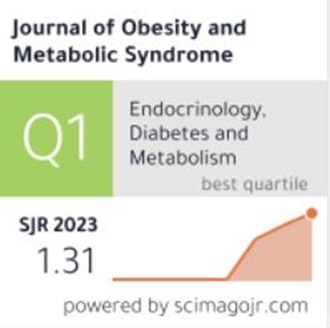信:在南印度成年人中,胰岛素抵抗和β细胞功能替代标志物识别代谢综合征及其组成部分的截止值和临床应用(J Obes Metab Syndr 2020;29:281-91)。
IF 4.7
Q1 ENDOCRINOLOGY & METABOLISM
引用次数: 2
摘要
本文章由计算机程序翻译,如有差异,请以英文原文为准。
Letter: Cut-off Values and Clinical Utility of Surrogate Markers for Insulin Resistance and Beta-Cell Function to Identify Metabolic Syndrome and Its Components among Southern Indian Adults (J Obes Metab Syndr 2020;29:281-91).
J Obes Metab Syndr 2021;30:403-404 Insulin resistance and visceral adiposity are common features of metabolic syndrome (MetS), although the pathophysiology of MetS is very complex.1 The hyperinsulinemic-euglycemic clamp technique is the “gold standard” test for the evaluation of insulin resistance and insulin sensitivity, but this method is time-consuming and inconvenient, making it difficult to use in a clinical setting. Therefore, many surrogate markers have been developed that can be used to evaluate insulin resistance and insulin sensitivity, starting with the homeostatic model assessment of insulin resistance (HOMA-IR) and quantitative insulin sensitivity check index.2 Endukuru et al.’s study3 is very informative in that the authors evaluated almost all known surrogate markers of insulin resistance and insulin sensitivity in the same study subjects. As a result, the authors3 presented a cut-off of several surrogate markers that can detect risk groups for MetS in Southern Indian adults. At the very least it is useful data for clinical application in the relevant region, although these results need to be confirmed with a larger number of study subjects in various regions. However, if some additional analysis was performed as follows, readers will be able to better understand and apply these findings to clinical practice. The first thing I would like to mention is the comparison of diagnostic values. In this study, the terms “higher,” “lower,” or “best” were used when presenting the area under the curve (AUC) values among various surrogate markers using the receiver operating characteristic (ROC). However, as the authors mentioned in the statistical section of the research methods, comparing diagnostic values using ROC is not simply a comparison of AUC values, so such expressions are inappropriate without providing statistical values. In other words, as in the study of Lee et al.,4 AUC comparisons should be performed using programs such as MedCalc (Ostend, Belgium) to determine the diagnostic value for MetS among surrogate markers and a P-value should be presented. Secondly, in this study, since controls were individually matched to cases by age and sex, the statistical analysis should be performed
求助全文
通过发布文献求助,成功后即可免费获取论文全文。
去求助
来源期刊

Journal of Obesity & Metabolic Syndrome
ENDOCRINOLOGY & METABOLISM-
CiteScore
8.30
自引率
9.60%
发文量
39
审稿时长
19 weeks
期刊介绍:
The journal was launched in 1992 and diverse studies on obesity have been published under the title of Journal of Korean Society for the Study of Obesity until 2004. Since 2017, volume 26, the title is now the Journal of Obesity & Metabolic Syndrome (pISSN 2508-6235, eISSN 2508-7576). The journal is published quarterly on March 30th, June 30th, September 30th and December 30th. The official title of the journal is now "Journal of Obesity & Metabolic Syndrome" and the abbreviated title is "J Obes Metab Syndr". Index words from medical subject headings (MeSH) list of Index Medicus are included in each article to facilitate article search. Some or all of the articles of this journal are included in the index of PubMed, PubMed Central, Scopus, Embase, DOAJ, Ebsco, KCI, KoreaMed, KoMCI, Science Central, Crossref Metadata Search, Google Scholar, and Emerging Sources Citation Index (ESCI).
 求助内容:
求助内容: 应助结果提醒方式:
应助结果提醒方式:


